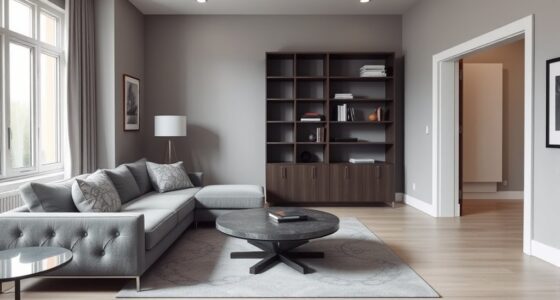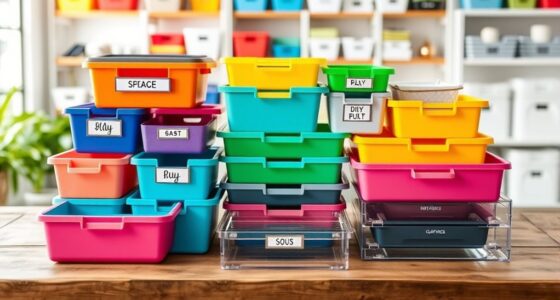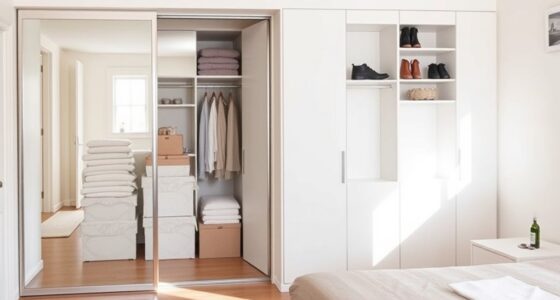To declutter without regret, focus on what truly sparks joy in your life and make mindful decisions about each item. Visualize your ideal space to stay motivated and handle sentimental items with care, honoring their emotional value. Create a personalized system that fits your habits and space, and build sustainable routines to maintain it. If you want to learn more about embracing the joy-driven method, keep exploring these helpful tips.
Key Takeaways
- Focus on whether items spark joy, not emotional attachment or guilt, to make decluttering easier.
- Visualize your ideal space daily to stay motivated and clarify your decluttering goals.
- Handle sentimental items with care, honoring their emotional value while assessing if they truly bring joy.
- Recognize and accept emotional responses during decluttering to prevent regret and promote compassionate decision-making.
- Categorize items by emotional significance to manage attachments and preserve meaningful memories effectively.
Understanding the Joy-Driven Method

To effectively declutter your space, you need to understand the core principle behind Marie Kondo’s approach: the joy-driven method. This method encourages you to focus on what sparks joy, rather than what you feel emotionally attached to. Emotional attachment can cause decision paralysis, making it hard to let go of belongings even if they no longer serve you. Kondo suggests asking yourself if an item truly brings happiness, rather than holding onto things out of guilt or obligation. This shift in mindset helps you prioritize joy over sentimentality, making decisions clearer and easier. By focusing on what lifts your spirits, you eliminate clutter efficiently and create a space filled with items that genuinely inspire positivity. Incorporating personal well-being tips such as creating a calming environment can further enhance your decluttering journey.
The Power of Visualizing Your Ideal Space
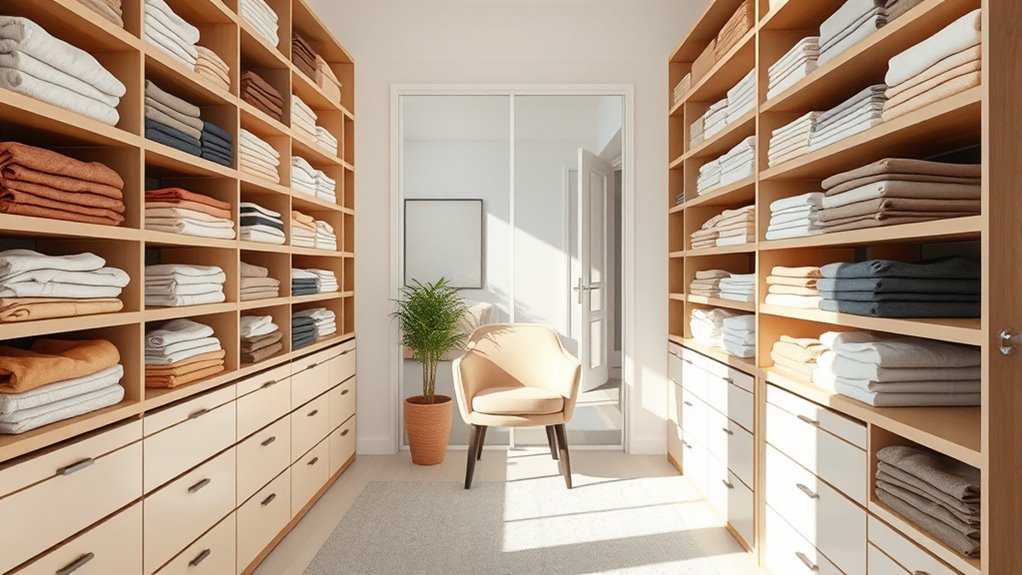
Visualizing your ideal space is a powerful step that guides your decluttering journey. Using visualization techniques, you create clear mental imagery of the environment you desire. This mental imagery helps you stay focused and motivated, making decisions easier. Picture your space tidy, organized, and calming—this vision acts as your goal. To enhance this process, try closing your eyes and imagining yourself in your perfect room, observing every detail. Incorporating mindfulness practices can deepen your visualization and increase your awareness of your surroundings. Here’s a simple visualization chart:
| Step | Technique | Outcome |
|---|---|---|
| Define your goal | Picture your ideal space | Clear mental imagery |
| Engage senses | Visualize sounds, textures | Heightened emotional connection |
| Focus your mind | Use breathing to deepen imagery | Increased clarity |
| Reinforce vision | Repeat visualization daily | Stronger motivation |
Making Decisions: Keep, Discard, or Store
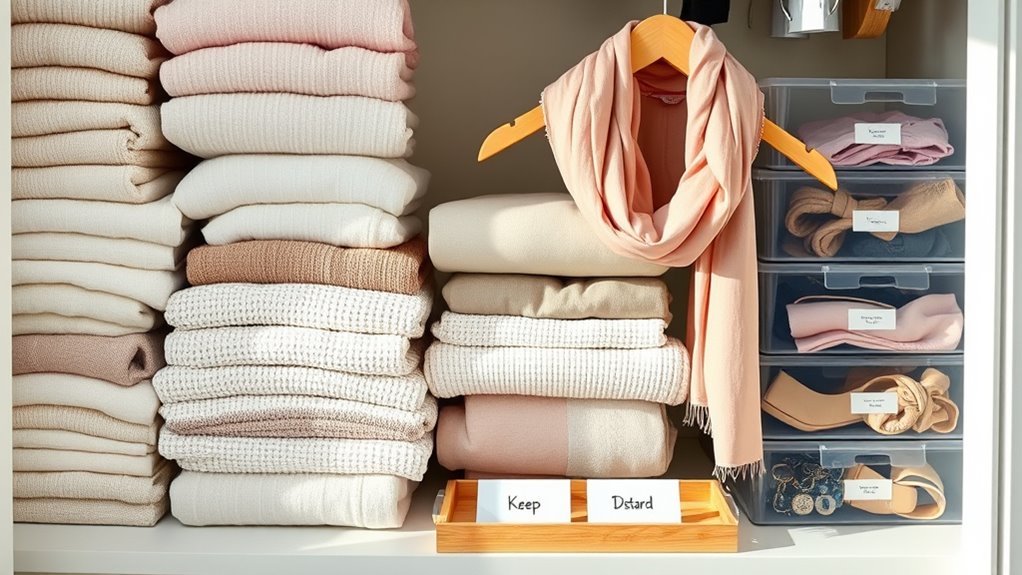
Once you’ve created a clear mental image of your ideal space, the next step is making concrete decisions about the items in your environment. Decide whether each item should be kept, discarded, or stored. Ask yourself if it sparks joy, and consider how often you use it. Effective storage solutions are essential—use containers, labels, or designated spaces to keep things organized. This process also improves your time management, as knowing exactly where everything is saves you from searching and stress. Be honest with yourself; holding onto things out of guilt or obligation only clutters your space and mind. Making quick, confident choices helps maintain momentum and ensures your decluttering efforts are sustainable. Incorporating storage solutions can further streamline your space and make organization more manageable. Ultimately, clear decisions lead to a more organized, peaceful environment.
Handling Sentimental Items With Care

Handling sentimental items requires gentle consideration and a thoughtful approach. These objects often hold significant sentimental value, representing memories and emotional attachment. To manage them effectively, take time to reflect on their importance before making decisions. Ask yourself if each item truly sparks joy or if it’s simply tied to the past. If you choose to keep something, handle it carefully, appreciating its significance. For items with strong emotional attachment, consider photographing or creating a keepsake to preserve the memory without cluttering your space. Remember, it’s okay to let go of some items if they no longer serve you or evoke positive feelings. Handling these belongings with kindness helps honor their sentimental value while maintaining a clutter-free environment. Additionally, understanding the best beaches can inspire you to create a relaxing, joyful space in your home, reinforcing the idea that decluttering is ultimately about making room for positive experiences.
Creating a System That Works for You
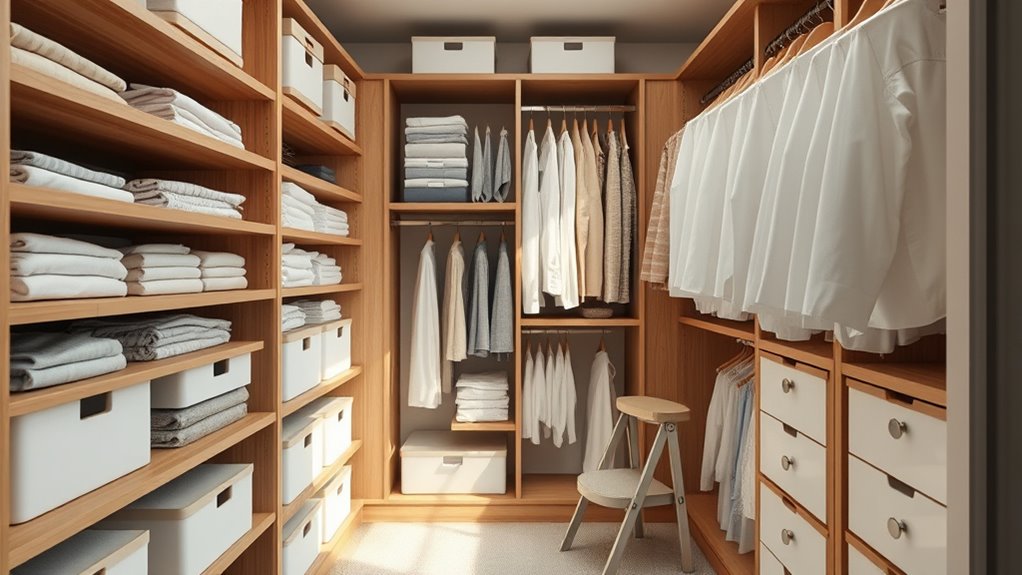
After carefully sorting through your sentimental items, the next step is to develop a system that keeps your space organized and manageable. Personalizing your storage solutions ensures they suit your habits and space, making organization effortless. Choose containers and labels that resonate with you, encouraging consistent use. To build lasting habits, incorporate small, daily routines—like returning items to their designated spot immediately. This consistency creates a reliable system that requires minimal effort over time. Consider this structure:
| Storage Type | Purpose | Habit Formation Tip |
|---|---|---|
| Clear bins | Easy visibility | Return items immediately |
| Drawer dividers | Maximize space | Clean and reorganize weekly |
| Labeling | Clear categorization | Use descriptive labels |
| Shelves | Accessible storage | Place frequently used items at eye level |
Implementing organized storage strategies can significantly enhance your decluttering efforts, making your system sustainable and personalized.
Maintaining Your Clutter-Free Environment

To keep your space clutter-free, establish regular organization routines that fit your lifestyle. Make it a habit to reassess your belongings periodically and ask if each item still sparks joy. Staying consistent with these practices will help your environment stay tidy and meaningful. Incorporating vertical storage solutions can further maximize space and maintain order over time.
Consistent Organization Routines
Maintaining a clutter-free environment requires establishing consistent organization routines that become part of your daily life. You need effective storage solutions that make tidying quick and intuitive, so clutter doesn’t build up. Incorporate time management into your routine by setting aside a few minutes each day to put things back in their designated spots. This habit prevents messes from accumulating and keeps your space orderly. Prioritize tasks like tidying after meals or before bed to reinforce your routines. Consistency is key; even small daily efforts can markedly reduce clutter over time. By integrating these routines into your schedule, organization becomes effortless rather than burdensome, helping you sustain a serene, clutter-free environment long-term. Clutter prevention is also important in maintaining your organized space.
Thoughtful Item Reassessment
Regularly reassessing your belongings guarantees your space stays clutter-free and meaningful. Over time, your feelings about items may change, especially when emotional attachment or sentimental value wavers. To maintain clarity, consider these steps:
- Question if the item still sparks joy or serves a purpose
- Reflect on the emotional attachment you have and if it’s worth holding onto
- Prioritize items that genuinely add value to your life
- Let go of possessions that no longer align with your current self
- Reorganize to keep meaningful items accessible and appreciated
- Incorporate sustainable decluttering practices to minimize waste and environmental impact
Embracing the Emotional Side of Decluttering

Although decluttering often feels like a physical task, it’s also an emotional journey that can stir up unexpected feelings. You might feel sentimental attachment to certain items or worry about losing memories. Recognizing this helps you approach decluttering with compassion. To manage these emotions, consider this table:
| Item Type | Emotional Attachment | Memory Preservation |
|---|---|---|
| Childhood belongings | High | Cherished memories |
| Sentimental gifts | Moderate | Special moments |
| Everyday essentials | Low | Practical use |
| Rare keepsakes | Very high | Personal history |
Additionally, understanding the neural networks involved in human emotion can help you navigate feelings of attachment more effectively.
Frequently Asked Questions
How Do I Stay Motivated During Long Decluttering Sessions?
Staying motivated during long decluttering sessions can be tough, but you can do it by incorporating mindfulness practices to stay present and focused. Break your tasks into smaller chunks, and use reward strategies to celebrate each milestone. Reminding yourself of the benefits, like a more organized space, keeps your spirits high. Keep a positive mindset, and take regular breaks to recharge, making the process feel less overwhelming.
What if I Regret Discarding a Sentimental Item Later?
Think of regret as a shadow that lingers after a decision. If you later feel emotional attachment to a discarded item, remember that decluttering is about honoring your space, not erasing memories. To ease decision regret, set aside sentimental items temporarily before finalizing, so you can revisit. Trust your initial judgment, knowing that your memories aren’t stored in objects but in your heart and mind.
How Can I Involve Family Members in Decluttering?
To involve your family in decluttering, foster family teamwork by encouraging shared decision making. Talk openly about each person’s belongings, respecting their feelings and opinions. Set common goals and create a supportive environment where everyone feels heard. By working together, you’ll make the process smoother, reduce resistance, and guarantee that all members feel involved and valued, making decluttering a positive experience for the whole family.
What Are Expert Tips for Decluttering Small Spaces?
When decluttering small spaces, focus on smart storage solutions like multi-functional furniture and vertical storage. Use space optimization techniques to maximize every inch, such as under-bed storage or wall-mounted shelves. Keep only essentials and items that spark joy to prevent clutter from piling up. Regularly reassess your space, and stay consistent with organization habits. These steps help you create a tidy, functional environment without feeling overwhelmed.
How Often Should I Revisit My Decluttering System?
You should revisit your decluttering system every few months to keep your space organized. Regularly assess your storage solutions and adjust them as needed to prevent clutter buildup. Incorporate digital decluttering into your routine, deleting unnecessary files and emails, and organizing digital spaces. This guarantees your environment stays tidy and functional. Consistent reviews help you stay on top of clutter, making it easier to maintain a calm, organized home.
Conclusion
So, there you have it—your foolproof, regret-proof guide to decluttering, courtesy of Marie Kondo’s magic. Who knew that tidying up could be so emotionally taxing and wildly satisfying all at once? Just remember, it’s not about perfection but about creating a space where everything sparks joy—unless, of course, you’re secretly hoarding that vintage sock collection. Happy decluttering, and may your closets forever stay drama-free.


